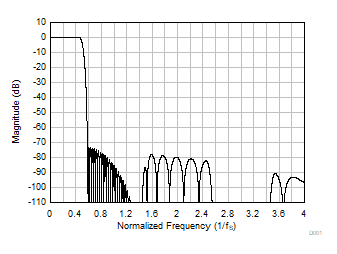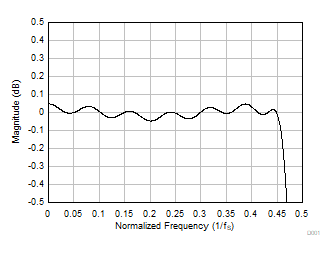SBASB12 May 2024 PCM1809
PRODUCTION DATA
- 1
- 1 Features
- 2 Applications
- 3 Description
- 4 Pin Configuration and Functions
- 5 Specifications
-
6 Detailed Description
- 6.1 Overview
- 6.2 Functional Block Diagram
- 6.3
Feature Description
- 6.3.1 Hardware Control
- 6.3.2 Audio Serial Interfaces
- 6.3.3 Phase-Locked Loop (PLL) and Clock Generation
- 6.3.4 Input Channel Configurations
- 6.3.5 Reference Voltage
- 6.3.6
Signal-Chain Processing
- 6.3.6.1 Digital High-Pass Filter
- 6.3.6.2
Configurable Digital Decimation Filters
- 6.3.6.2.1
Linear Phase Filters
- 6.3.6.2.1.1 Sampling Rate: 8 kHz or 7.35 kHz
- 6.3.6.2.1.2 Sampling Rate: 16 kHz or 14.7 kHz
- 6.3.6.2.1.3 Sampling Rate: 24 kHz or 22.05 kHz
- 6.3.6.2.1.4 Sampling Rate: 32 kHz or 29.4 kHz
- 6.3.6.2.1.5 Sampling Rate: 48 kHz or 44.1 kHz
- 6.3.6.2.1.6 Sampling Rate: 96 kHz or 88.2 kHz
- 6.3.6.2.1.7 Sampling Rate: 192 kHz or 176.4 kHz
- 6.3.6.2.2 Low-Latency Filters
- 6.3.6.2.1
Linear Phase Filters
- 6.4 Device Functional Modes
- 7 Application and Implementation
- 8 Power Supply Recommendations
- 9 Layout
- 10Device and Documentation Support
- 11Revision History
- 12Mechanical, Packaging, and Orderable Information
Package Options
Mechanical Data (Package|Pins)
- RTE|20
Thermal pad, mechanical data (Package|Pins)
Orderable Information
6.3.6.2.1.3 Sampling Rate: 24 kHz or 22.05 kHz
Figure 6-15 and Figure 6-16 respectively show the magnitude response and the pass-band ripple for a decimation filter with a sampling rate of 24 kHz or 22.05 kHz. Table 6-10 lists the specifications for a decimation filter with an 24-kHz or 22.05-kHz sampling rate.
 Figure 6-15 Linear Phase Decimation Filter Magnitude Response
Figure 6-15 Linear Phase Decimation Filter Magnitude Response Figure 6-16 Linear Phase Decimation Filter Pass-Band Ripple
Figure 6-16 Linear Phase Decimation Filter Pass-Band RippleTable 6-10 Linear Phase Decimation Filter Specifications
| PARAMETER | TEST CONDITIONS | MIN | TYP | MAX | UNIT |
|---|---|---|---|---|---|
| Pass-band ripple | Frequency range is 0 to 0.454 × fS | –0.05 | 0.05 | dB | |
| Stop-band attenuation | Frequency range is 0.58 × fS to 4 × fS | 73.0 | dB | ||
| Frequency range is 4 × fS onwards | 96.4 | ||||
| Group delay or latency | Frequency range is 0 to 0.454 × fS | 16.6 | 1/fS |